The poll winner for the start of 2021 is Growing Up, by Hax Shannon, and it's a rough one.
ZZT has its history of edgy games made by tactless teenagers that take any criticism of how serious topics are handled with a response of little more than a "fuck you". Growing Up, however, is hardly an edgy title by a teenager. It's a much more modern world, created in that very quiet era where ZZT had mostly gone away. As a 2014 release it shares that year with just four other ZZT worlds, and of its contemporaries, only Shannon brought something this serious to the table.
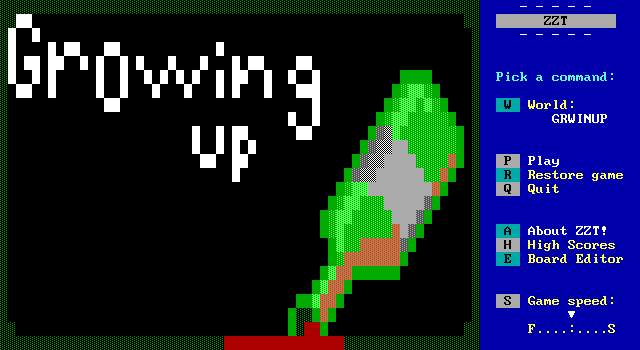
Growing Up is a very short game with very little to do, but that's okay because it's a story first and foremost. It tackles some rather heavy subjects through the perspective of a young teenager. In particular, well, let's get the content warning block here from the very start.
The following content contains material which may be offensive to some audiences. This material does not necessarily reflect its creator's current opinions /behaviors.
Specifically, content following this notice contains depictions of or references to:
- Alcoholism
- Self-Harm
- Domestic Violence
- Sexual Content
Shannon describes the game in the included text file with simply: "this is a little game about trying to get out of the house to go on a walk". The game itself makes no warnings about its content, though the spilled bottle on the title screen doesn't exactly hide the more serious tone taken here. Growing Up is hardly the first ZZT game to deal with alcohol abuse, but it's probably the first to do so in a completely serious game. There aren't any jokes to be found here, just the unending anxiety of living with a family member suffering from an addiction and the strain that puts on the children in a single-parent household.
I can't recall where this game came from. It's too recent to be available on z2, but too new to have been rediscovered in somebody's personal ZZT folder. I have a vague recollection of this game being e-mailed to me from the author, but can't find any such e-mail today. The origins wouldn't typically be too important, but what I'm interested in here is the inspiration behind this one. I fear it's non-fictional. There's at least the relief that if this game is about actual events, or even sensationalized a bit for the sake of telling a story that the author has most certainly gotten themselves in a better position than when they were a powerless teenager trying to protect themselves and a younger sibling.
Often, when I do post a content warning for a ZZT game, I worry that my own pre-emptive explanation of what's going to be coming up may be making things sound worse than they are. The violence in this game is handled entirely through text, and while the protagonist is going to be shot at with ZZT bullets, they're almost certainly not intended to be treated as bullets being shot from a firearm. As always, if it hits too close to home, don't hesitate to opt out of spending time with this one.

Another quickly realized aspect of the game is that it's catered towards an audience that hasn't interacted with ZZT before. The date attributed to the world is barely a week after the release of Anna Anthropy's ZZT book. There's a real possibility that Shannon was a reader inspired to create something with ZZT. The text file includes instructions for setting up DOSBox (as this was years before Zeta), loading the world within ZZT, as well as a suggestion to check out the editor to make your own games.
But enough of the meta-text. Let's get to the game's actual text.


There's no specific date for the when the game takes place, but going by the release date, the teenage vibes given from the protagonist, and the options here, I would expect it to be sometime in the first decade of the 2000s. "See who's online" is almost certainly intended to be the protagonist checking their AOL buddy list.

See who's online.
The protag's personality is developed through these little interactions.

Write something.
Or perhaps what makes me think the player character is a teenager in the early 2000s is because Shannon does such an excellent job capturing my own teenage years in the early 2000s. The lack of confidence and fear of others seeing what you've made resonate deeply with a younger me. Having a PARENT like this one certainly wouldn't help. Whether they're the cause of the anxiety issues or just make them significantly worse is unclear.

Watch porn.
The combination of self-pleasure and self-flagellation is never a good one.


The mirror just adds more sadness to everything. The protag has yet to feel positive about anything so far.


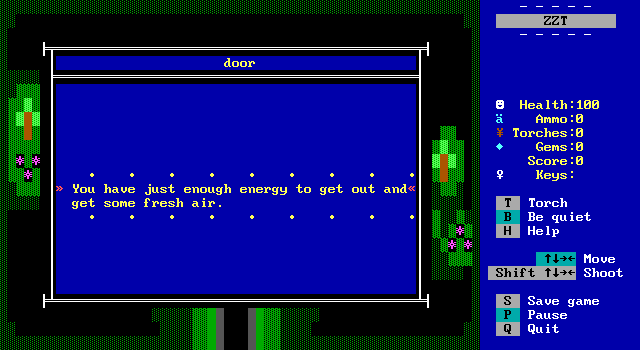
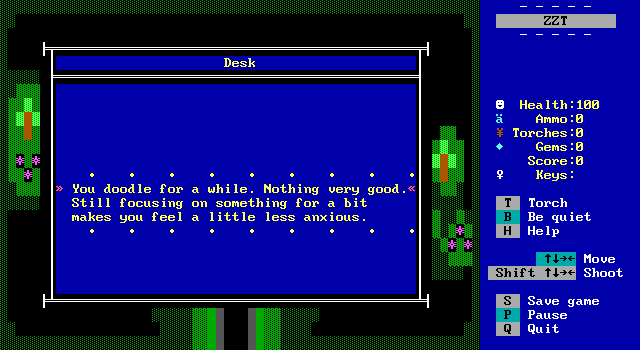
The desk actually offers some respite. There's a moment of relief in the distraction offered by drawing something, some satisfaction at a cleaner workspace, and even motivation to get outside and enjoy the day.
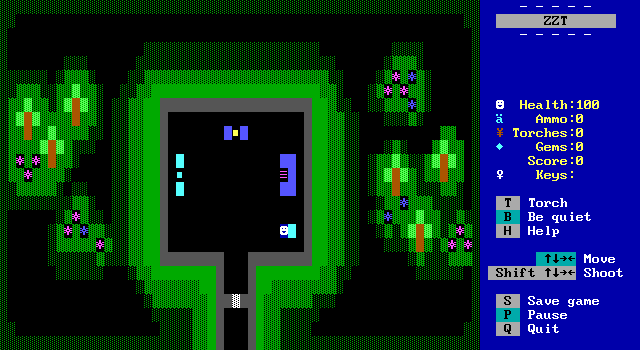
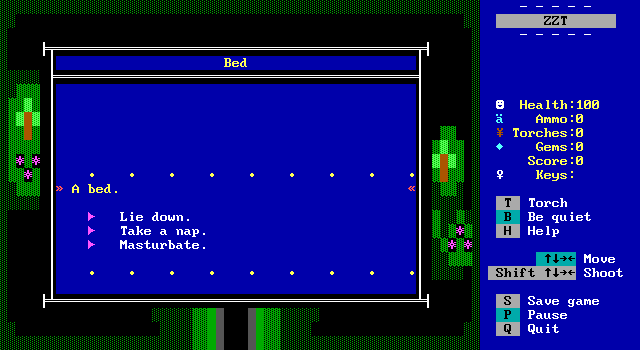
The last bit of furniture here is a bed offering a variety of depression related solutions.
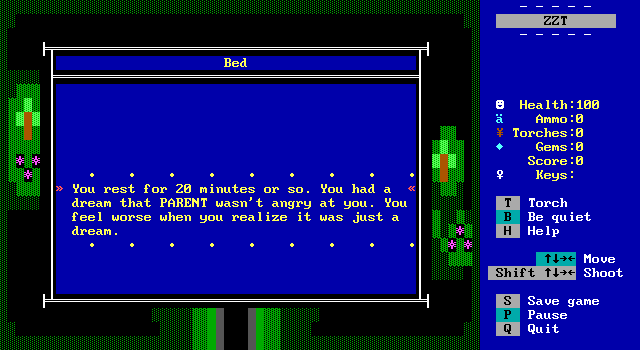
Take a nap.
Most notable is the text after napping. So much character is established for both PARENT and protagonist here. There's more development than in a lot of entire ZZT worlds.
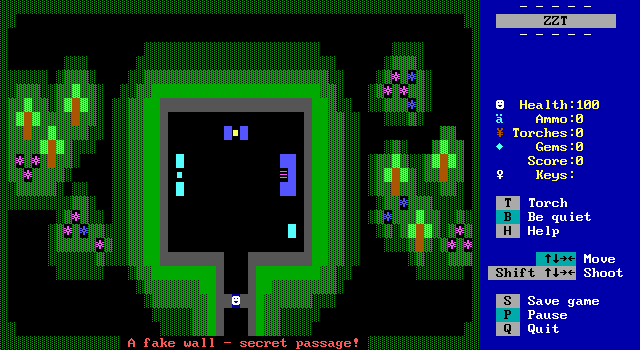
The exit to the room is blocked by a white-solid object that requires the player recover enough emotional health to want to leave the room in the first place. This can be done either by drawing or by masturbating in bed (where the protagonist mentions not feeling as ashamed when it's entirely imagination based).
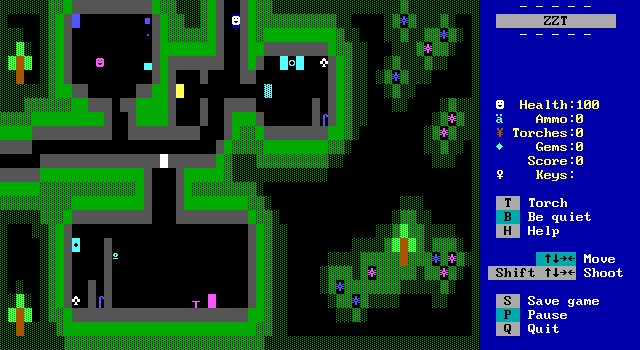
The unusual home layout continues as a long winding hall branches off into a bathroom, a closet, and two more bedrooms.
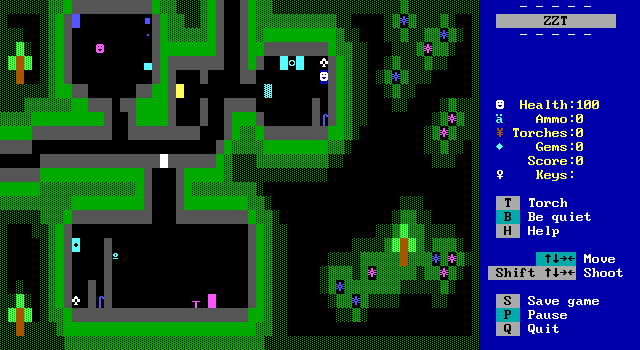
The bathroom is entirely decorative at this point with just simple messages explaining when you're touching a sink, toilet, or shower. This game is one of the rare ZZT worlds with a shower in the bathroom.
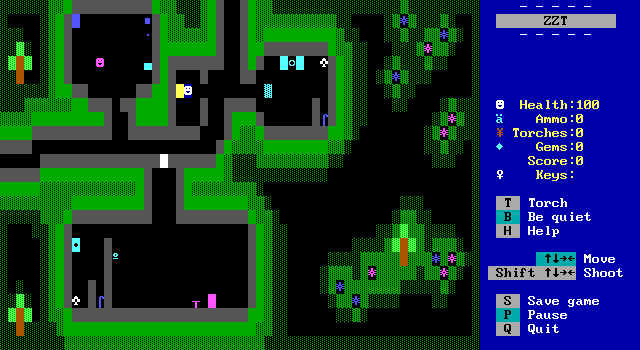
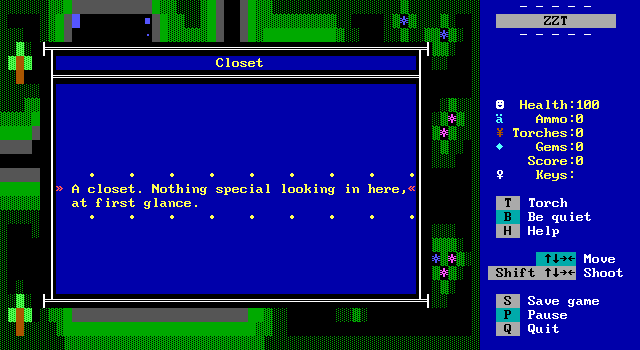
Continuing the unusual, the closet is both a room you enter and an object you interact with. Again, for the time being these rooms don't serve any purpose.
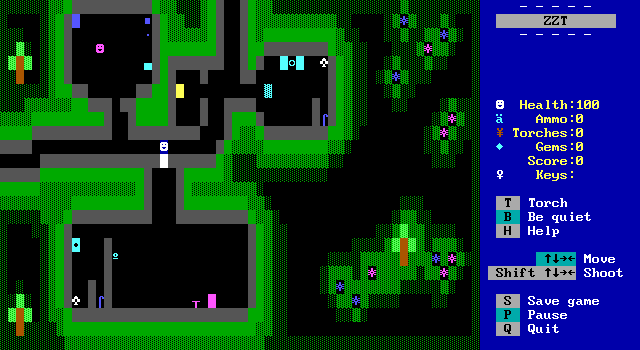
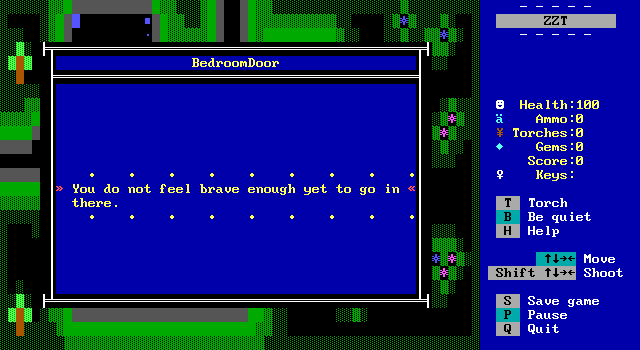
PARENT's room is completely off limits, blocked by another wall of willpower for the time being.
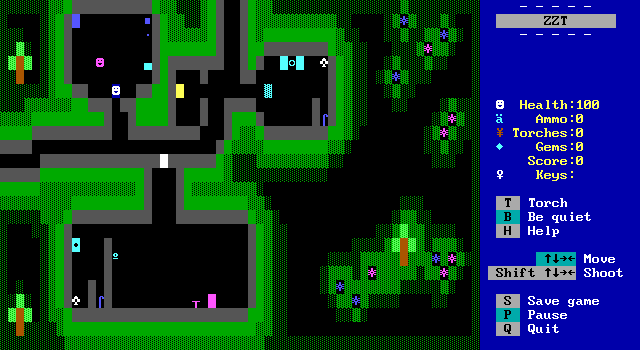
Protag's sibling has an open room though, and provides a chance to see if they're doing any better in this home.
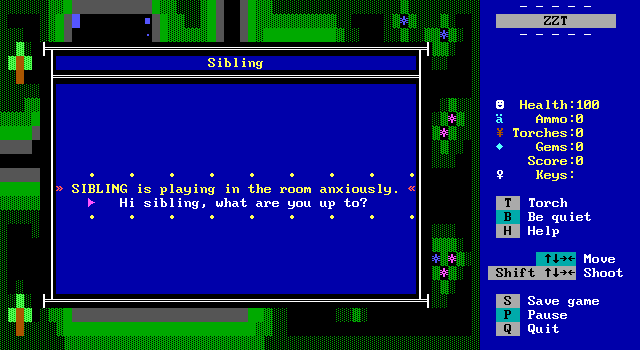
It doesn't look good for them either.
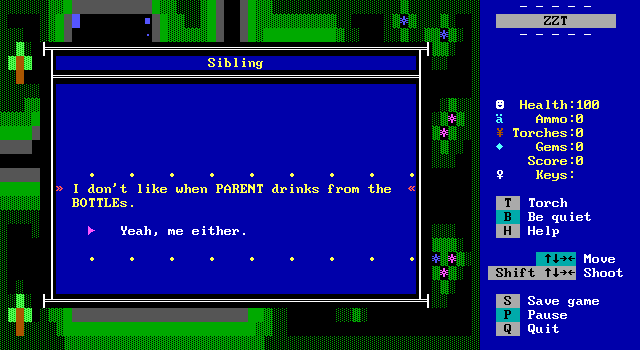
What an absolute downer of a game. There's so little to it, and I just want nothing more than to get these kids somewhere safe.
We haven't even met PARENT yet!
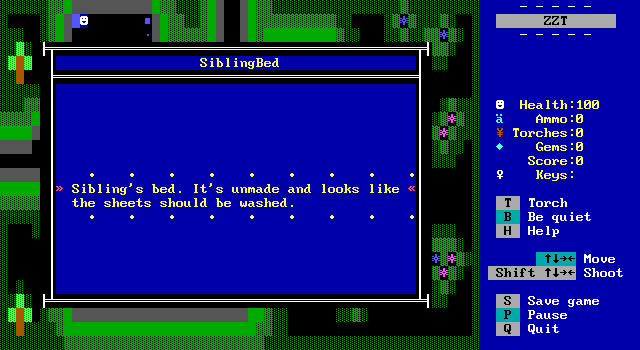
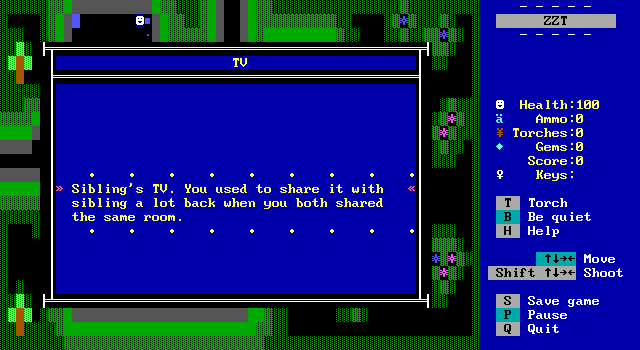

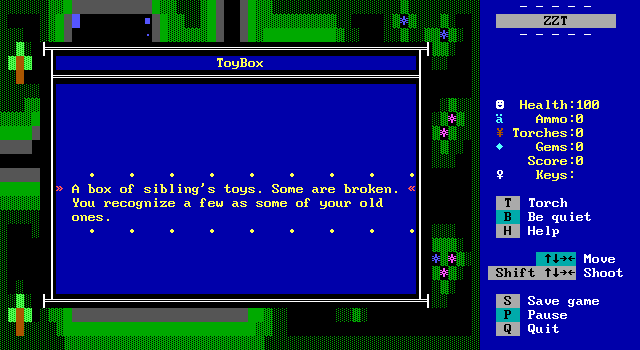
The furnishings are a step above the bathroom, but not as interactive as protag's bedroom. It makes sense though as these details establish the relationship between protag and sibling, help clarify the age difference between them, and even can offer some insight into the financial situation they're living under.
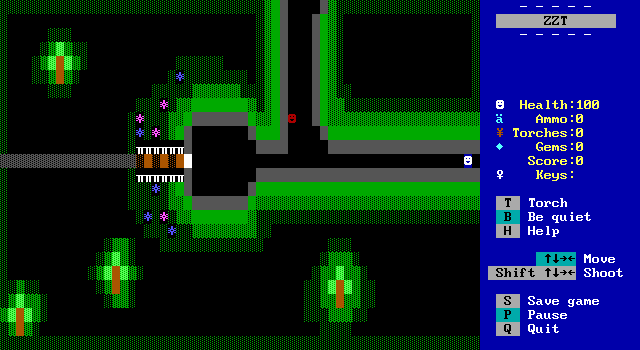
Finally we reach the front of the house, as well as PARENT. The protagonist's goal is in sight, but PARENT clearly has no intention of letting them out of the house. As soon as the board loads PARENT marches to the the south, blocking the way out and requiring a confrontation. Whether through Shannon's own unfamiliarity with ZZT-OOP or a conscious design choice, PARENT says nothing. They stand there until spoken to. (Attempting to head in the direction they came from will get them to demand you talk to them once you bump into some invisible objects up top.)
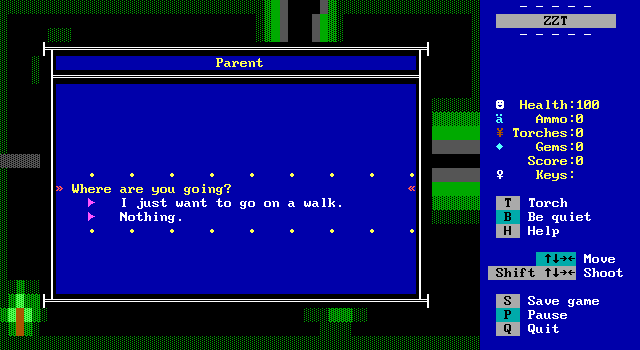
There's no narration about building up courage, or fear of having a bad encounter. It's entirely on you to take those steps and approach.
Two choices are presented, but both get the same response.
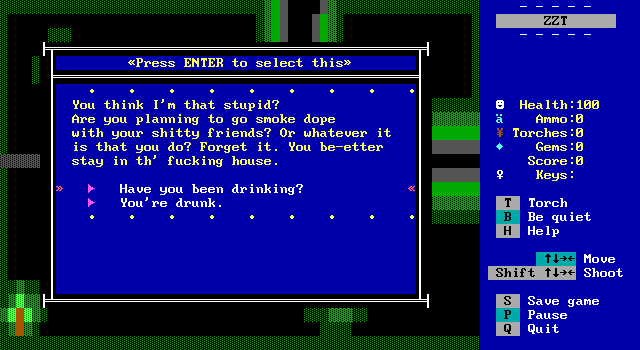
It's painful to hear. Perhaps it's a little too realistic. I had the good fortune of not having parents like this one, but drinking or not, I certainly had friends with parents like this one.
There is courage though. The protagonist again has two dialog choices with the same response, but these are much more direct responses spoken without fear. As a teenager, protag is very capable of understanding this situation, just with the frustration of feeling powerless to do anything about it.
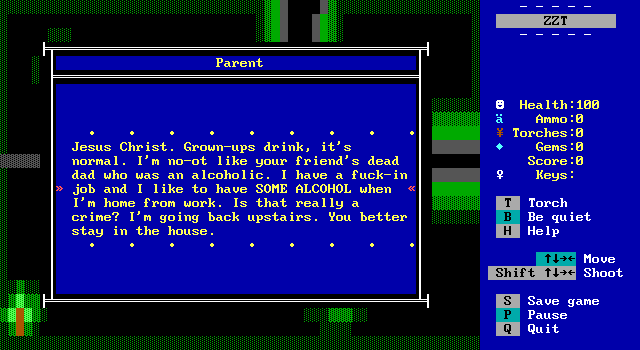
Were it not for my interest of putting all this behind a content warning, this would almost certainly be the preview image for this article. It sums everything up in one tidy scroll.
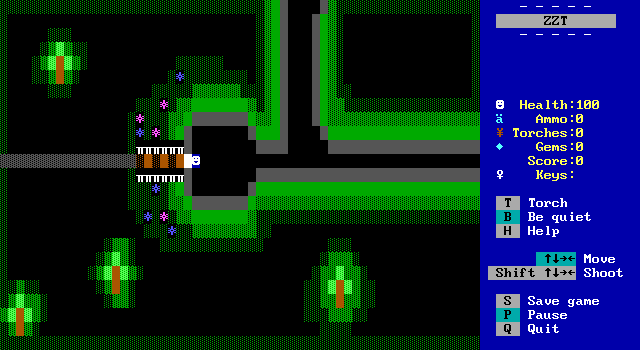
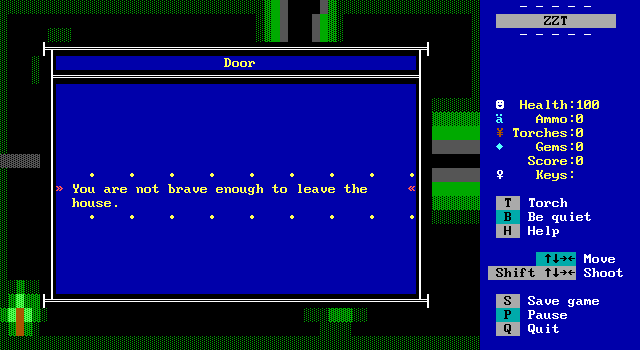
While they're confident enough to correctly call out PARENT on their drunkenness, they lack the confidence to defy them entirely.
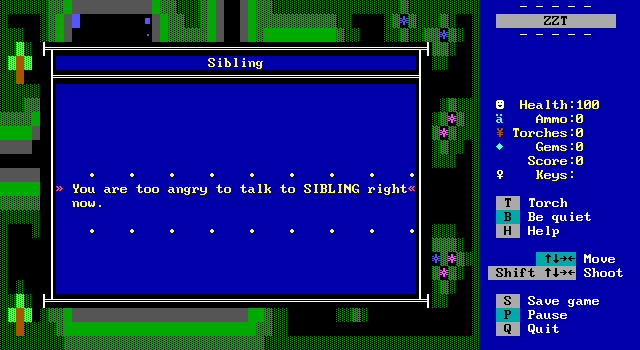
The game is rife with flags for tracking events. After dealing with a drunken PARENT, the protagonist is too angry to interact with anything but what Shannon will allow. I like this effect. It captures the kind of pure rage from being put into a situation like this.
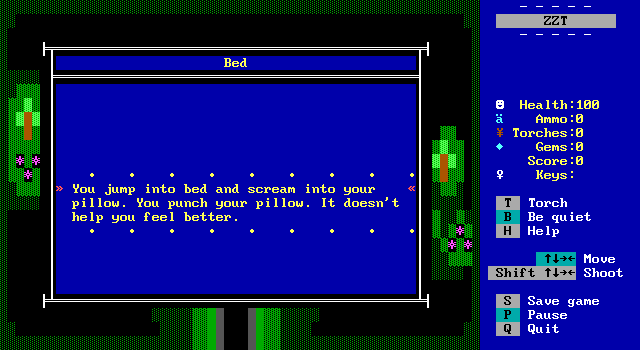
The more healthy outlets for protag's anger aren't enough to cope. Other parts of the room like the computer are locked away until they calm down again.
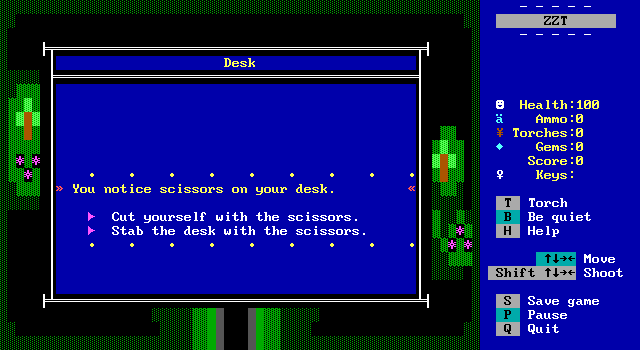
This may be the most distressing prompt I have ever seen in a ZZT world.
Unfortunately, choosing the latter option doens't make the protagonist feel any better. You have to commit.
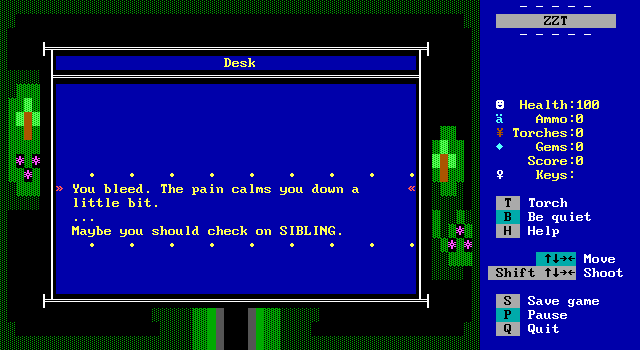
I went through my teenage years where self-harm with scissors and razor blades was a legit fear adults had that their children might do such a thing. It became a sort of iconic trope of depression, and for us teenage bullies, joking about the kinds of people who would do such a thing to themselves. Some fifteen years later, the weight of it hits much harder.
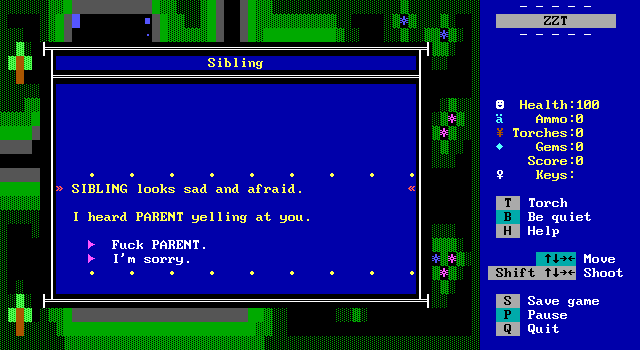
This is just what life is for these two kids. Constantly trying to avoid PARENT for their own health, and cowering when PARENT is taking out their frustrations on their sibling. In my teenage years I had two friends who were siblings that lived with a physically abusive parent. They were a year apart and the moment the younger one turned eighteen they both ran away to stay with somebody the next town over. I suspect that's how this relationship depicted here is going to go, with the older sibling staying longer than they have to, with a personal duty to protect the younger one.
What makes me believe this game's story is based on the author's own childhood traumas is how tragically there's nothing unbelievable about the situation.
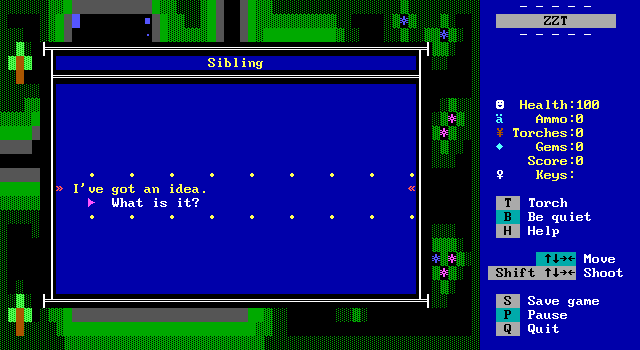
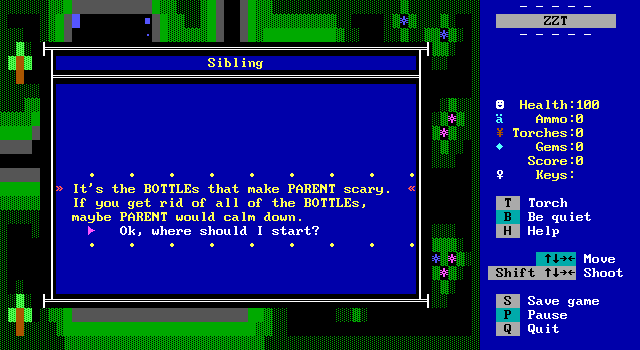
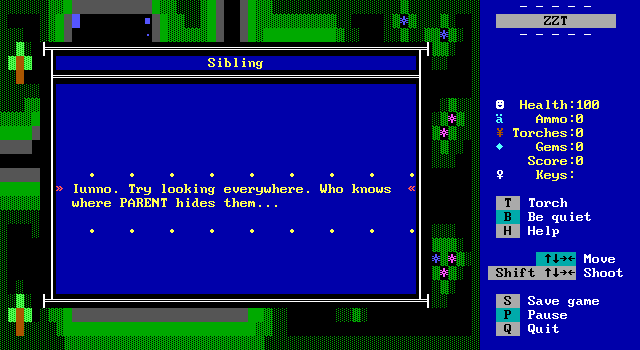
As you'd expect, both dialog options lead to the same path. There's a bolstering of confidence as the two are in this mess together. The plan is to find any alcohol and get rid of it.
This is obviously not the greatest plan. Emptying all the alcohol in the house may buy the siblings some relief in knowing PARENT can't get drunk, but of course PARENT can and will just buy more alcohol, and what consequences they might suffer for "wasting" the current supply and consequences for PARENT having to spend more money to replace it can put these two in an even more dangerous situation.
At the same time though, doing nothing certainly isn't going to help either. A stand is going to be taken and the hope is that even a temporary respite will be worth whatever happens afterwards.
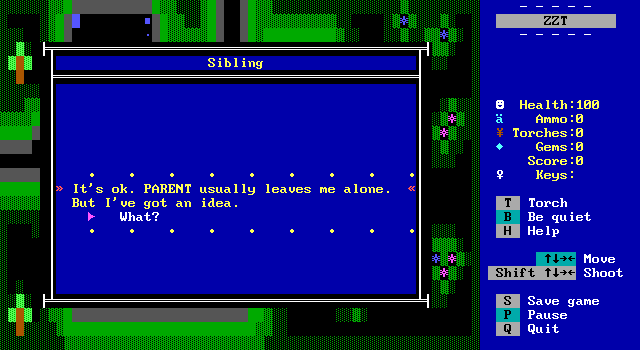
Although both initial choices in the dialog lead to the same plan, the other is worth showing off as it reveals that PARENT focuses their frustrations on just the protagonist. There's no doubt the fear that running away and leaving SIBLING behind likely means them becoming the new target of PARENT's abuse.
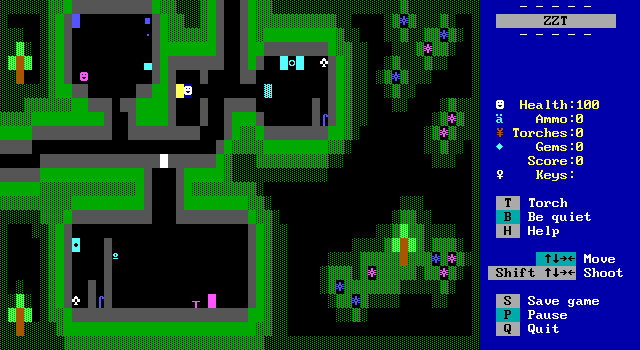
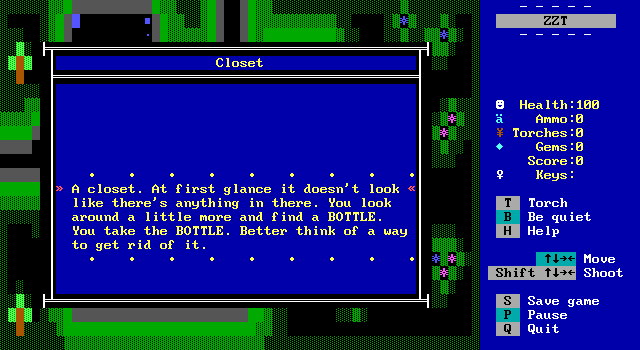
From here Growing Up turns into a game of hide-and-seek. There are bottles hidden around the home and your job is to find them and dispose of them.
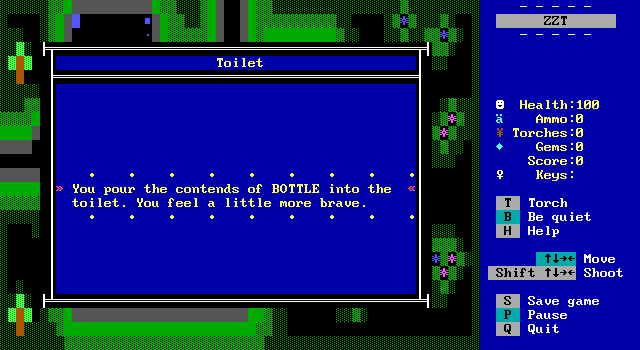
There's a confidence boost with each bottle, or perhaps the realization that there's no going back now. Although the protagonist won't yet enter PARENT's room, they will go upstairs to the last part of the house.
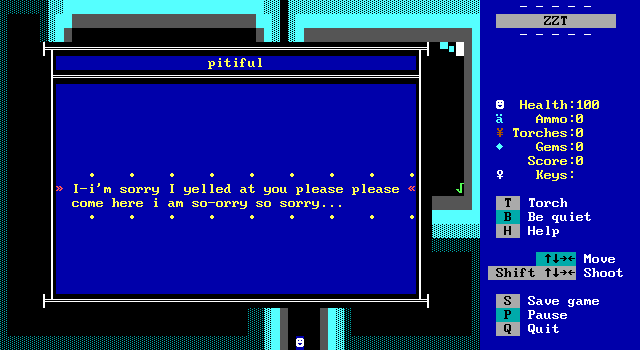
Before protag can do anything, PARENT, still drunk, remorsefully asks for forgiveness to how they treated them.
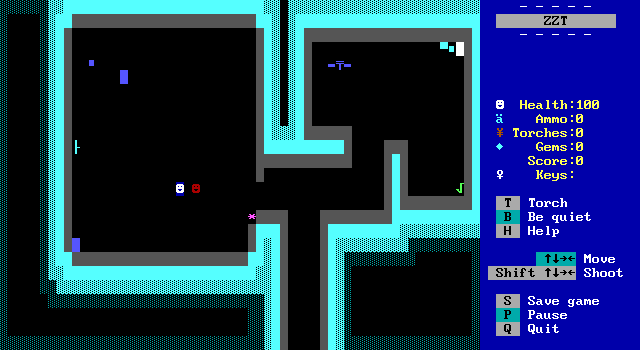
The upper level is even more difficult to interpret. A drunken PARENT stumbles towards the protagonist, and this time they don't have to talk if they don't want to.
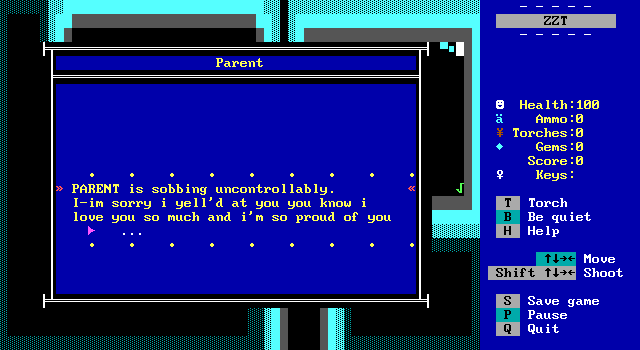
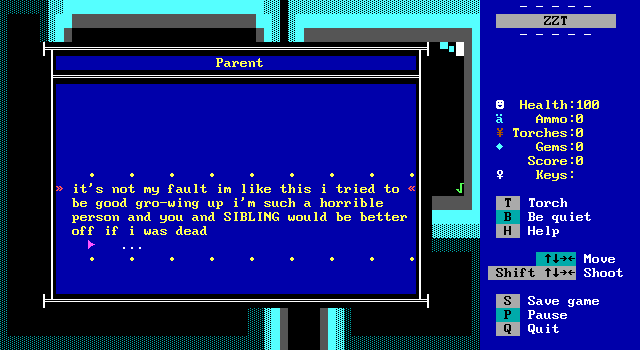
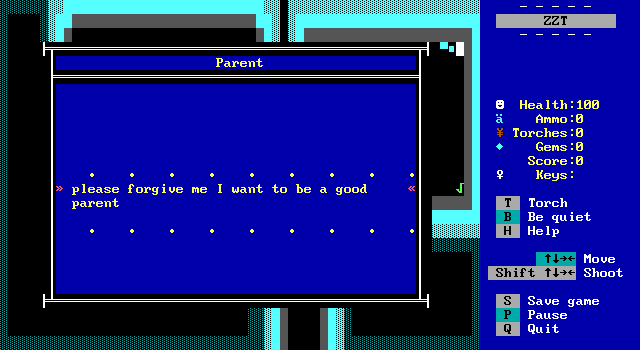
It's powerful stuff. PARENT isn't evil, and clearly has quite a few problems of their own. Nonetheless, you can have sympathy for PARENT's struggles with alcohol abuse and still see the harm they're inflicting on the siblings regularly. This is a story first about childhood survival, and PARENT's regrets are rightly approached with caution and skepticism.
The living room furniture isn't as useful at painting a scene like the bedrooms were, but I want to include the screenshot of this one because it's an odd detail to include.
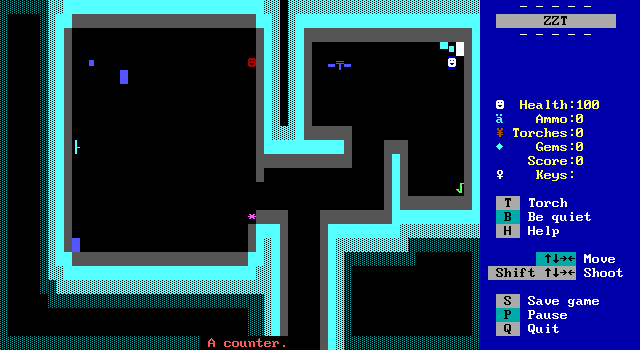
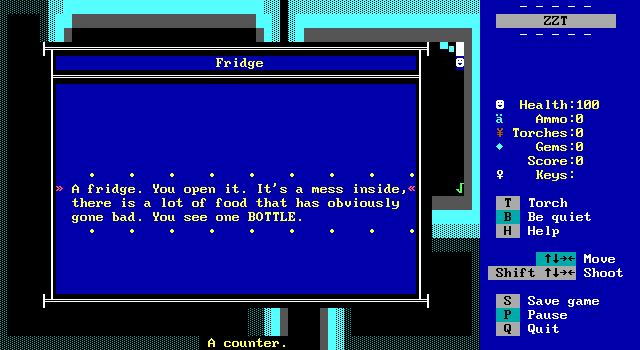
The kitchen is more important though. There's no surprise at finding the second BOTTLE here. The real surprise is the protagonist's bravery in grabbing it from the fridge with PARENT so close by.
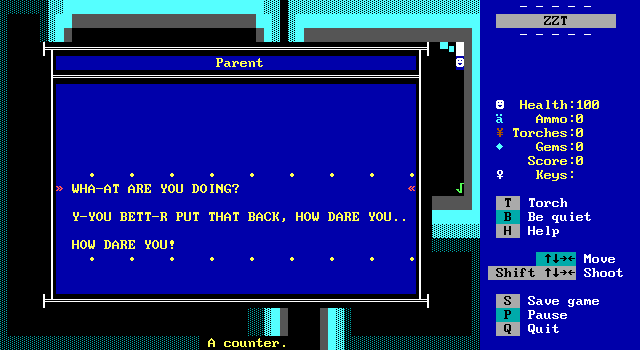
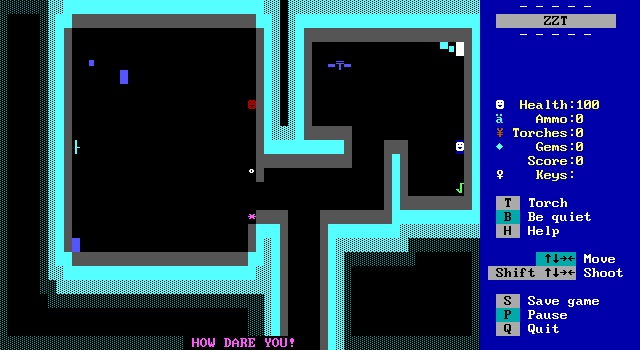

Whether or not the apology was sincere, it's quickly revoked once PARENT realizes what's happening. This is when they get violent. They begin to alternate between moving and shooting towards the player. It's a slow enough movement that even if you let them get close you can pretty safely avoid their shots.
It's also an area where as stated in the intro, I suspect we're not meant to take the bullets as literal bullets. Still, they're violent towards a child, and the protagonist is unable to reason with them or fight back. The only option is to run to the bathroom to empty the second BOTTLE.
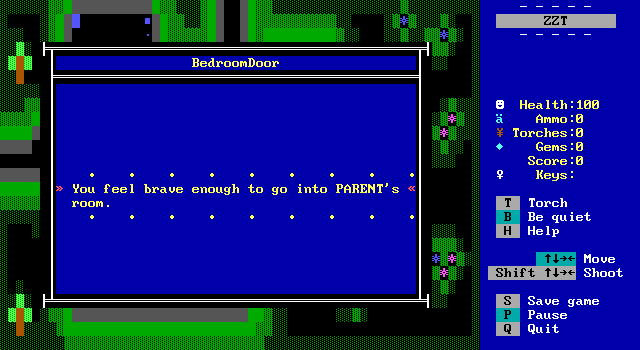
Which in turn leads to being brave enough to check PARENT's bedroom for more alcohol.
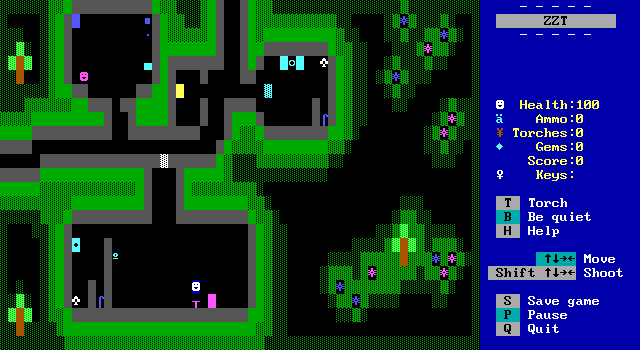
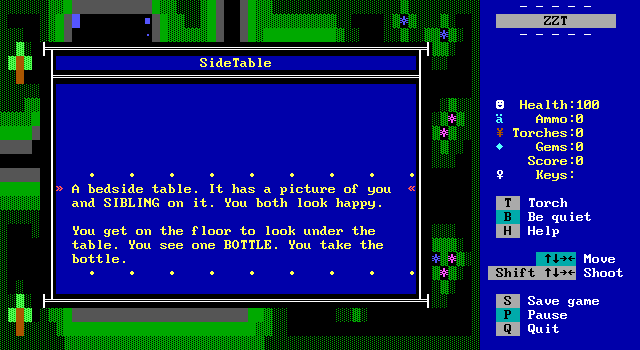
The story hits hard.
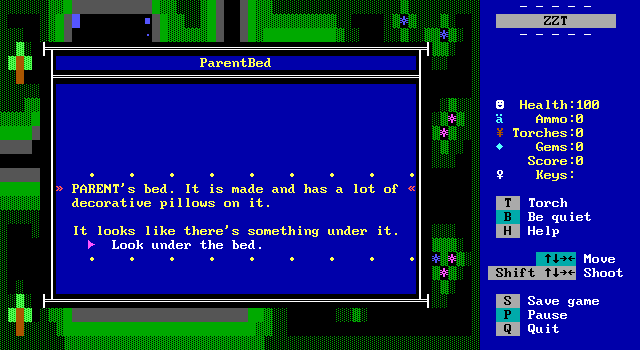
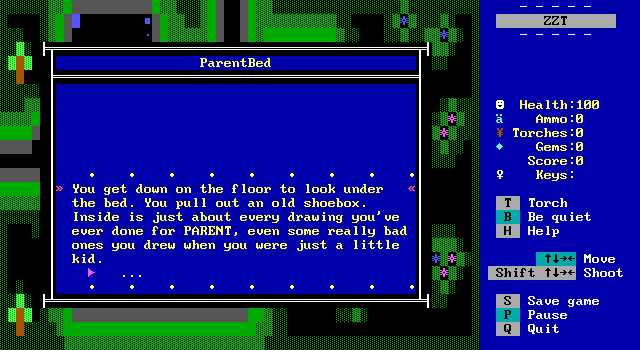
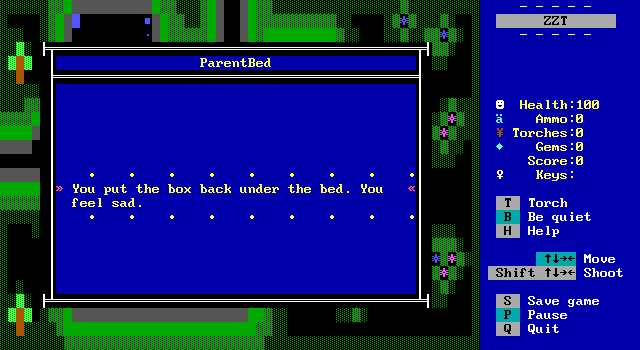
Even harder if you keep exploring. Part of what makes it so hard to leave an abusive situation like this one is that the abuser isn't always hostile. PARENT is a tragic figure here who needs help just as much as the kids do. It's enough to convince me that the apology was genuine, but I'm sure that it's not the first time PARENT apologized. If they don't make changes, PARENT is going to continue their self-destructive and abusive behavior. It'll take more than a glimpse at more loving parenting to grow and heal from living life this way.
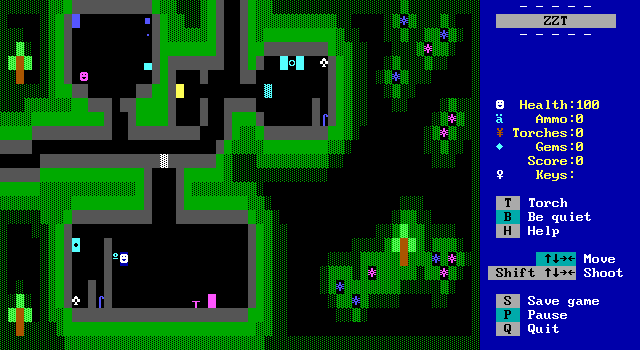
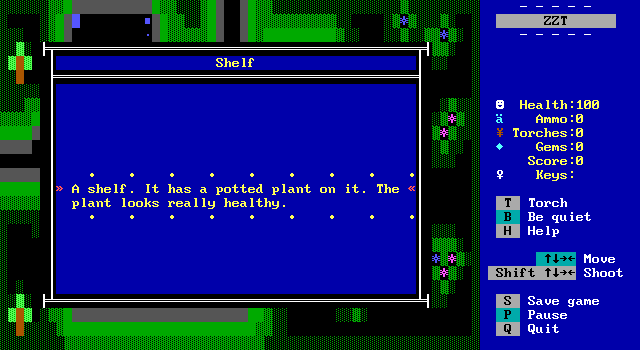
Not to deviate from how heavy this situation is, but hey, creative ASCII character here for a plant on a shelf.
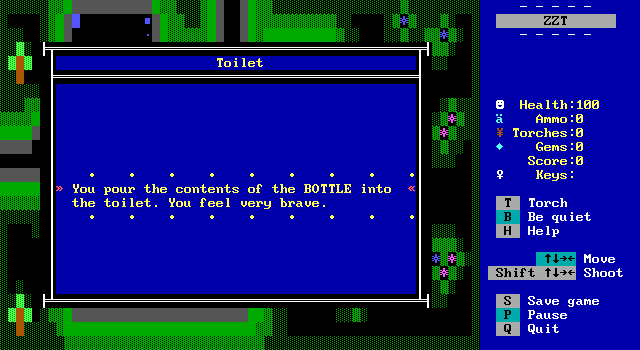
The deed is done and the house is now dry.
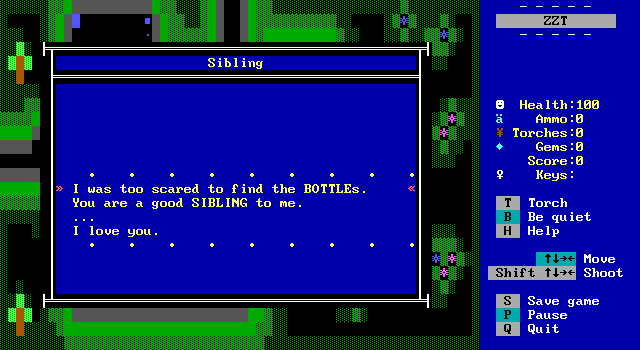
SIBLING is scared, but trusts protagonist. The knowledge that they care for each other and want to protect one another gives them some much needed strength and support.
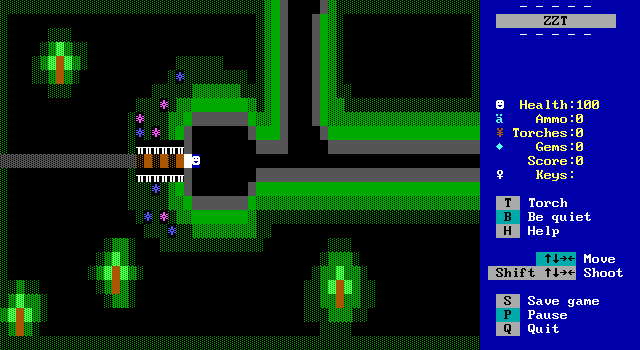
It's time to go.
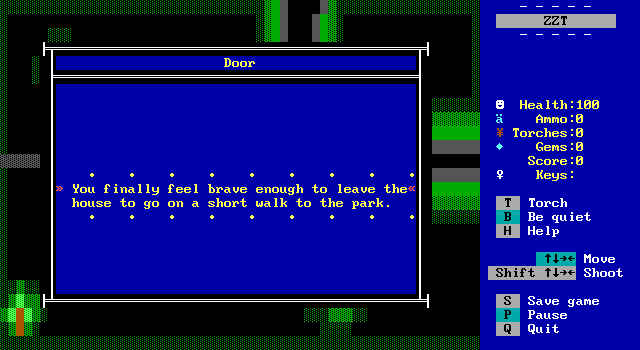
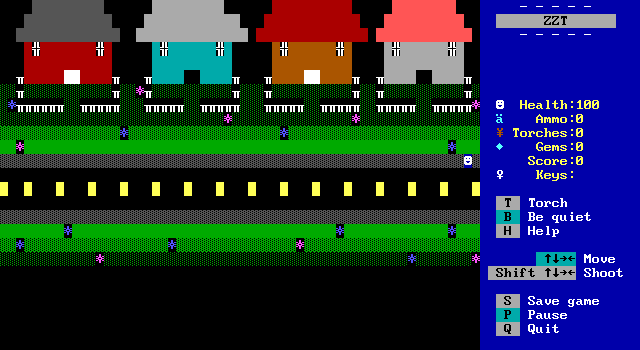
It would be very easy for Growing Up to outright end after leaving the house, or connect directly to the park, but Shannon delivers on the walk. You can't interact with anything, you just get to take in the scenery and decompress. For now at least, things can be calm.
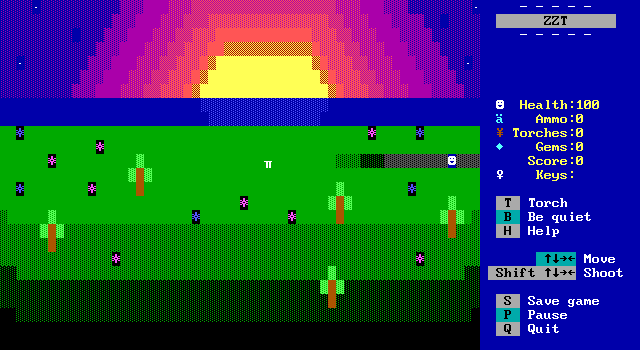
The park board itself is quite gorgeous. The stars in the sky twinkle while the sun sets over a body of water. ZZT sunsets are a dime a dozen, and you'll find no shortages of ZZT parks with trees and flowers. What makes this one special is that it has such an impact. After the dark events back home, you'll find yourself truly appreciating the beauty of the scene so much more than you would in most games. There's an emotional toll taken on you to get through this game, making it one of the more powerful stories I've seen in a ZZT game.
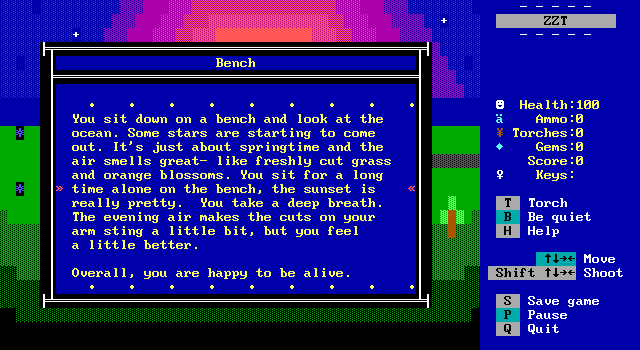
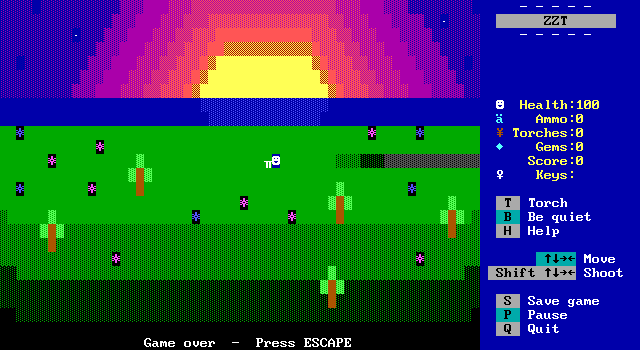
Final Thoughts
Growing Up hits hard. It easily packs more emotion into seven boards than most worlds can do with seventy. Shannon's story is one that's all too common, and for those of us fortunate enough to have grown up under better circumstances, most likely you're familiar with somebody who's childhood was more like the one depicted here. Regardless of whether this whole game is based on true events, or even if it was merely a short story entirely fictionalized, you can't help but be sucked into this world. You'll be brought to a time where a teenager had to hold on to what little they could, a sibling, friends online, creative outlets, whatever they needed to keep themselves in an okay state physically and mentally as best as they could to defy the forces around them. The fear of a younger sibling who has a plan that they can't bring themselves to act upon, or that of the protagonist hurting themselves for a form of control, it all resonates deeply. These characters aren't even given names and I want nothing more than to get them out of that house and away from PARENT.
And I can't help but appreciate the design of PARENT too! Suffering from alcoholism, they find themselves hurting themselves, their child, and almost guaranteeing that these two will one day be long long gone. For a ZZT villain, they're very effective at demonstrating why the kids are so anxious and afraid, but they're still a human in need of help as well. The ending here isn't really a happy one. When the protagonist heads home, there's no telling what awaits them, but Shannon does a brilliant job of depicting those precious moments of peace. Sitting on that bench, watching the sun go down, the protagonist can finally stop thinking about home and let themselves relax, even if it's for just a little while.
I've praised ZZT's ability to tell stories, and for somebody new to ZZT Shannon has done an impeccable job here. There's no complex scripting, no cutscenes, and the artwork would fit right in with a game from 1996, but none of that matters because this is a game that serves to tell a story and it does everything it needs to. So many ZZT games rejected being taken seriously, and plenty of them that wanted to be failed spectacularly at getting the audience invested. Growing Up pulls you in on the very first board and you'll find yourself unable to pull yourself away as the story develops. If you can stomach the serious subject matter, this one is a must play.

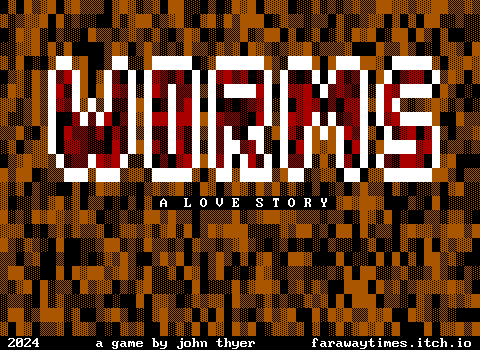

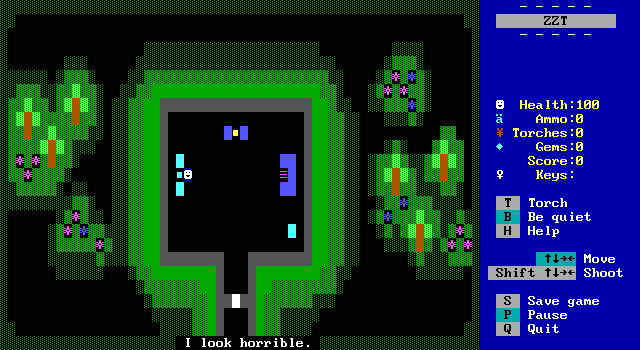
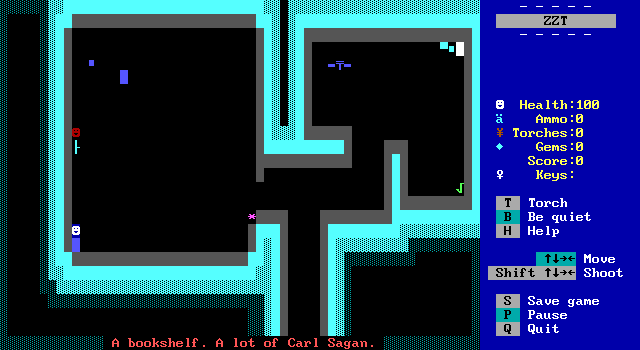
Our title screen is a spilled bottle of booze and some basic text. No date, no credits, just a title card.
It's worth noting as well that this game seems to have been made using ZZT's default editor. While you won't find any yellow borders, you will run across borders on most boards. The file also includes two tool kits as well as a copy of the title screen for STK, perhaps as an unusual method of crediting Janson.